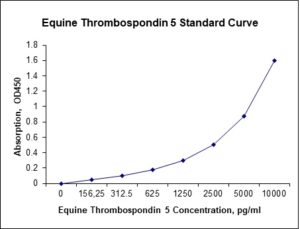Nori Equine COMP ELISA Kit
$461.00 – $832.00
This ELISA kit is for quantification of COMP in horse. This is a quick ELISA assay that reduces time to 50% compared to the conventional method, and the entire assay only takes 3 hours. This assay employs the quantitative sandwich enzyme immunoassay technique and uses biotin-streptavidin chemistry to improve the performance of the assays. An antibody specific for COMP has been pre-coated onto a microplate. Standards and samples are pipetted into the wells and any COMP present is bound by the immobilized antibody. After washing away any unbound substances, a detection antibody specific for COMP is added to the wells. Following wash to remove any unbound antibody reagent, a detection reagent is added. After intensive wash a substrate solution is added to the wells and color develops in proportion to the amount of COMP bound in the initial step. The color development is stopped, and the intensity of the color is measured.
Alternative names for COMP: Cartilage oligomeric matrix protein (COMP), thrombospondin-5
This product is for Laboratory Research Use Only not for diagnostic and therapeutic purposes or any other purposes.
- Description
- How Elisa Works
- Product Citation (0)
- Reviews (0)
Description
Nori Equine COMP ELISA Kit Summary
Alternative names for COMP: Cartilage oligomeric matrix protein (COMP), thrombospondin-5
Alternative names for equine: horse
| Assay Type | Solid Phase Sandwich ELISA |
| Format | 96-well Microplate or 96-Well Strip Microplate |
| Method of Detection | Colorimetric |
| Number of Targets Detected | 1 |
| Target Antigen Accession Number | A0A3Q2HRL2 |
| Assay Length | 3 hours |
| Quantitative/Semiquantitative | Quantitative |
| Sample Type | Plasma, Serum, Cell Culture, Urine, Cell/Tissue Lysates, Synovial Fluid, BAL, |
| Recommended Sample Dilution (Plasma/Serum) | No dilution for sample <ULOQ; sufficient dilution for samples >ULOQ |
| Sensitivity | 30 pg/mL |
| Detection Range | 0.156-10 ng/mL |
| Specificity | Equine COMP |
| Cross-Reactivity | < 0.5% cross-reactivity observed with available related molecules, < 50% cross-species reactivity observed with species tested. |
| Interference | No significant interference observed with available related molecules |
| Storage/Stability | 4 ºC for up to 6 months |
| Usage | For Laboratory Research Use Only. Not for diagnostic or therapeutic use. |
| Additional Notes | The kit allows for use in multiple experiments. |
Standard Curve
Kit Components
1. Pre-coated 96-well Microplate
2. Biotinylated Detection Antibody
3. Streptavidin-HRP Conjugate
4. Lyophilized Standards
5. TMB One-Step Substrate
6. Stop Solution
7. 20 x PBS
8. Assay Buffer
Other Materials Required but not Provided:
1. Microplate Reader capable of measuring absorption at 450 nm
2. Log-log graph paper or computer and software for ELISA data analysis
3. Precision pipettes (1-1000 µl)
4. Multi-channel pipettes (300 µl)
5. Distilled or deionized water
Protocol Outline
1. Prepare all reagents, samples and standards as instructed in the datasheet.
2. Add 100 µl of Standard or samples to each well and incubate 1 h at RT.
3. Add 100 µl of Working Detection Antibody to each well and incubate 1 h at RT.
4. Add 100 µl of Working Streptavidin-HRP to each well and incubate 20 min at RT.
5. Add 100 µl of Substrate to each well and incubate 5-30 min at RT.
6. Add 50 µl of Stop Solution to each well and read at 450 nm immediately.
Background:
Cartilage oligomeric matrix protein (COMP), also known as thrombospondin-5, is an extracellular matrix (ECM) protein primarily present in cartilage. In Equines it is encoded by the COMP gene.[1][2] COMP is a noncollagenous ECM protein.[3] It consists of five identical glycoprotein subunits, each with EGF-like and calcium-binding (thrombospondin-like) domains. Oligomerization results from formation of a five-stranded coiled coil and disulfide bonds. Binding to other ECM proteins such as collagen appears to depend on divalent cations. Mutations can cause the osteochondrodysplasias pseudoachondroplasia (PSACH) and multiple epiphyseal dysplasia (MED). COMP is a marker of cartilage turnover.[4] It is present in high quantities in fibrotic scars and systemic sclerosis, and it appears to have a role in vascular wall remodeling.[5] Cartilage oligomeric matrix protein shows high affinity zinc-dependent interaction with triple helical collagen.[6]
References
- Newton G, et al. (1994). Genomics. 24 (3): 435–9.
- Briggs MD, et al. (1993). Genomics. 18 (3): 656–60.
- Paulsson M, Heinegård D (1981). The Biochemical Journal. 197 (2): 367–75.
- Petersen SG, et al. (2010). Osteoarthritis and Cartilage / OARS, Osteoarthritis Research Society. 18 (1): 34–40.
- Halper J, Kjaer M (2014). Advances in Experimental Medicine and Biology. 802: 31–47.
- Rosenberg K, et al. (1998). The Journal of Biological Chemistry. 273 (32): 20397–403.
Be the first to review “Nori Equine COMP ELISA Kit”
You must be logged in to post a review.




























Reviews
There are no reviews yet.